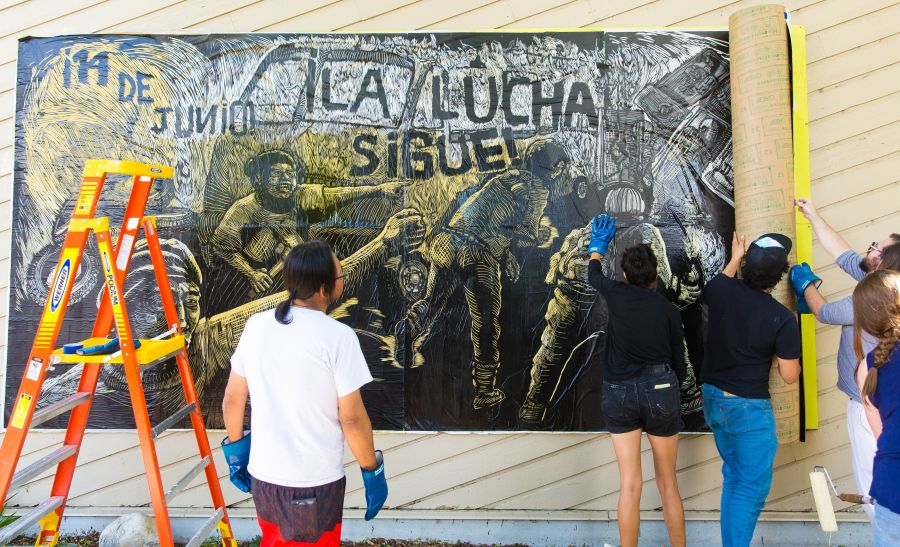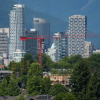It's terrifying. It's beautiful. It knocks you over the head with its subject matter, its colossal scale and its portrayal of man's inhumanity to man and to the planet.

"It" is the summer show at the Penticton Art Gallery's main gallery that opened last Friday night. Entitled "A Picture is Worth a Thousand Words," the exhibit features the works of artists from a very special part of Mexico, a state called Oaxaca, where art, primarily print art, and brutally graphic social commentary mix as one.

As a bonus, Gallery curator Paul Crawford brought two of the young artists at the centre of the Oaxaca scene -- 22-year-old Andre Matias Martinez and 33-year-old Eloisa Flores -- to town for the opening and for a series of workshops.

"I went to Oaxaca in January," said Crawford Friday evening. "I was walking the streets and looking around and you just can’t avoid the street art down there.
"It's become an industry and I was blown away by the art. By the size, the scale, the colours, the subject, the fact that they were real prints, not photocopies."

Crawford investigated and found that much of the art was created by two "collectives." He visited both and fell in love with the people, the techniques, and the motivation.
"I don’t think we have a tradition of political art here," said Crawford. "We sell a lot of pretty pictures and there's nothing wrong with that, but we generally don’t have art that makes you think.
"And the other thing that got me? The social concerns that affect their communities are also affecting ours. Immigration, poverty, the environment, racism. We're a world away, but we're all the same."

We chatted with Martinez, who more comfortably discusses his art in English than his compatriot Flores. Both are part of the "Subterráneo" collective.
"The boom was in 2006," said Martinez in explaining the rise to prominence of Oaxacan art. "There was a big manifestation against the governor. His name was Ulises Ruiz Ortiz. He was stealing the payments of teachers. So the teachers had a big manifestation in (the city of) Oaxaca de Juarez.
"They were there for a few weeks and the governor sent the police and took them out with violence. People disappeared, people died.

"That was the beginning of art on the streets. I was very young, but I remember being in the streets and seeing barricades. Tear gas. I remember that."
Martinez, who's self-taught, acknowledges the anger that shines though in his work and that of other Oaxacan artists.
"In the beginning I made small things without meaning," he said, "but after that I started making critical social work. I am mad. I really hate the things that happen in Mexico."

And his art, and that of his collective, extends far beyond current events. Much of the prints hanging at the Gallery now goes back hundreds of years.
"When the Spanish conquest of Mexico happened, they killed more than 90% of the indigenous population that existed there," said Martinez. "Then they needed to make churches, so they brought black people from Africa as slaves.
"They crossed the sea, and the tradition was pretty horrible. When they got sick they'd just throw them from the ship and they'd drown. We have a series that speaks about that."

Oaxacan printmaking is an exercise in both skill and patience. Artists begin by drawing their design on a 4x8 sheet of MDF or pressboard. Bigger works need more sheets (called "plates").
Next, they'll carve out the design they’ve drawn. Ink is then applied (the carved areas will appear as white, the uncarved areas will be printed) and the final prints are made.
"There are a lot of techniques involved in each work," laughed Martinez.

The crowd at the Friday opening arrived fashionably late. "It's nice to see people, and lots of people, coming out," said Crawford. "The Gallery was hopping with a huge diversity of people I haven't seen in a long time."
Still, the most interesting part of the day may have happened a few hours earlier when Martinez and Flores and a small contingent from the Gallery walked across Okanagan Lake Park and plastered a typically huge Oaxacan print on the bare white wall of the Rotary Park washroom facility.

Street art meet Penticton.
Also in the summer show is "Lasting Impressions," a look at the democratization of art in the Toni Onley Gallery.
"It's the origins of the democratization of art, when print making came into its own, allowing average people to put art in their homes," said Crawford, dropping names like Albrecht Dürer, Rembrandt and William Hogarth.

In the Project Room is "Southern Cross," a riveting presentation of Southern Cross: A Novel of the South, a wordless 1951 book by Canadian artist Laurence Hyde that protested America's nuclear bomb testing over Bikini Atoll post-World War II.
You'll find the Penticton Art Gallery at 199 Marina Way. Go here for more information.

















